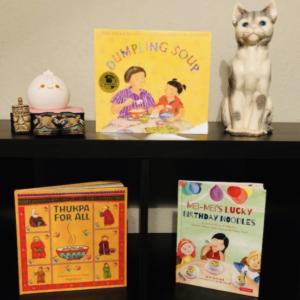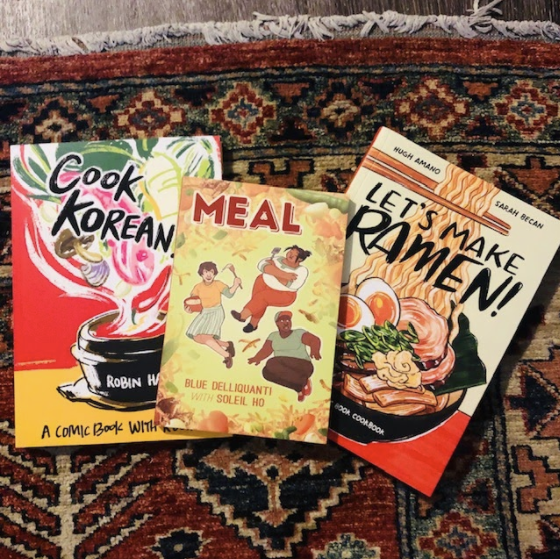Cooking has often been my way to reset. I get a sense of control and am able to sit down to a meal with my loved ones and get out of my work mode. These days, cooking has changed for me a bit. I need to cook every meal and many times I am exhausted by the necessity of this chore. The thought of cooking dinner after figuring out both breakfast and lunch becomes overwhelming and somehow sad. It’s like the last bit of my mind is Sisyphus rolling a boulder up a hill but about food, and I love food.
Through this difficult reality we are currently facing, I have dived straight into books. That seems to be my quiet place these days, where my brain just has to absorb the text and enjoy its time away from thinking and planning and stressing. And since cooking is more about survival than taste or culinary flair during quarantine, I have found that reading about food has been the escape I needed more than anything else. My brain relaxes more when I can dream up all the things I want to make when I don’t have to watch my budget and can source all those items correctly instead of getting my supermarket substitute ingredients.
Currently, I have been diving into several Asian food books, partially because that is my wheelhouse when it comes to cooking but also because I miss my family. Asian food is the primary food we eat together. I like to read children’s books with recipes with my younger family members to try to get them excited about trying different foods. Along with a few children’s books with Asian recipes, some other suggestions can be found the last time I wrote about this topic, I have also found some wonderful graphic novels with recipes. I’ve been on a bit of a graphic novel kick recently and these books have been a welcome addition to my collection.
Kid’s Books with Recipes
 Thupka for All by Praba Ram
Thupka for All by Praba Ram
This sweet book has a lovely sense of compassion and togetherness that I have been longing for these days. Tsering, a blind boy, is making his way home to eat his grandmother’s thupka (noodle soup). Along the way, he meets several people, who join him on this journey, each bringing a dish. It looks like the evening is set for a wonderful meal with friends and family until the lights go out. Can Tsering help his grandmother cook thupka and save the day? I’ll leave you this cliffhanger, but know that at the end of your reading you probably will want to call someone you love and reminisce about a lovely meal together, I know I did.
Mei-Mei’s Lucky Birthday Noodles by Shan-Shan Chen
This is such a cute story about celebrating culture. Mei-Mei is adopted from China and her parents celebrate her birthday every year by preparing her birthday noodles. She explains that her parents cook these noodles because long noodles signify a long life in Chinese heritage. She is excited to share her birthday noodles with her friends and family. The recipe in the back of this book is so simple that kids would love both making this dish as well as eating it with giant smiles on their faces.
Dumpling Soup by Jama Kim Rattigan
I am pretty obsessed with dumplings. I love that they can have different fillings and that so many cultures have their own versions. Dumpling Soup is about eating dumplings in a mixed family in Hawaii. Marisa is very excited to be old enough to help make dumplings for New Year’s Day. Her whole family comes together on New Year’s Day and her grandmother and aunties make dumplings in different shapes. When Marisa struggles to make her dumplings look right, she gets frustrated but slowly those feelings disappear when she realizes that her broken dumplings make the soup taste delicious. Everyone who reads this book should definitely try their hands and making dumplings. They are surprisingly easy to make and lots of fun for the whole family.
Graphic Novels with Recipes
Cook Korean! by Robin Ha (@robinhaart)
When I was a kid my school would hold an international food festival and you could always find me at the Korean booth spending all my tickets on bulgogi. When I ran out of tickets I would likely get free portions since my brother’s best friend’s mother manned that bulgogi. This graphic novel has tons of history about types of Korean food and pantry ingredients that are pivotal to making those dishes. The pictures help share technique and make this unorthodox cookbook really pop. It has some recipes that I didn’t think I would ever try to replicate, but now I am second-guessing those thoughts. I plan on trying my hand at sundubu jjigae (soft tofu soup) and kimchi buchimgae (kimchi pancake). If I am feeling particularly ambitious, I’ll attempt making budaejjigae (army stew). Good thing I have the largest tub of gochujang (Korean red chili paste) in my fridge.
Let’s Make Ramen by Hugo Amano
Some of you might be thinking, “Ramen? I have some 25¢ instant packets in my pantry, why stress about ramen?” Well, for one, freshly made ramen is actually incredibly complex and it can take years for ramen cooks to perfect their bowls. Several years ago I read The Ramen King and I by Andy Raskin, which heavily features Momofuku Ando, the creator of those instant ramen packets. I found the story fascinating, but it still felt like it was missing the thoughtfulness of preparing ramen from scratch. Let’s Make Ramen has been the answer to several ramen related questions. It goes through the rich history of ramen and how it became popular to the different types of broth and what toppings pair with the broths and even ramen etiquette (the major rule I will tell you is never, EVER leave your chopsticks in the bowl sticking out, this goes for all Asian food). It is fascinating how much goes into creating one dish, but the results will make you forget all about that 25¢ packet.
Meal by Blue Delliquanti and Soleil Ho (@bluedelliquanti @soleil_ho)
I really enjoyed this graphic novel for all the different ways it asks you to expand your compassion and your palate. Meal is about a young aspiring chef named Yarrow and her desire to work in a new restaurant that features different bugs in every dish. When Yarrow is given the assignment to make a taco featuring insects by the restaurant chef Chanda, who she somehow insulted, she realized that she needs to make her food personal. After seeking out her ingredients from a seller who breeds grasshoppers for consumption, she shares her taco with Chanda. Yarrow explains that as a child she would often collect cicadas with her grandmother in the countrysides of Japan to later eat and her passion for cooking with insects is not a fad, but a part of her desire to share her heritage. Chanda explains that she has a similar history with her mother in Cambodia, who survived the Khmer Rouge partially by eating tarantulas. Several countries around the world eat insects, except for most of Europe, and their food culture heavily influenced America’s food culture. While the ambitious bug-centric recipes in the back might be difficult to source, the story does make me want to expand my view on food and what is deemed by some as daring ingredients.

